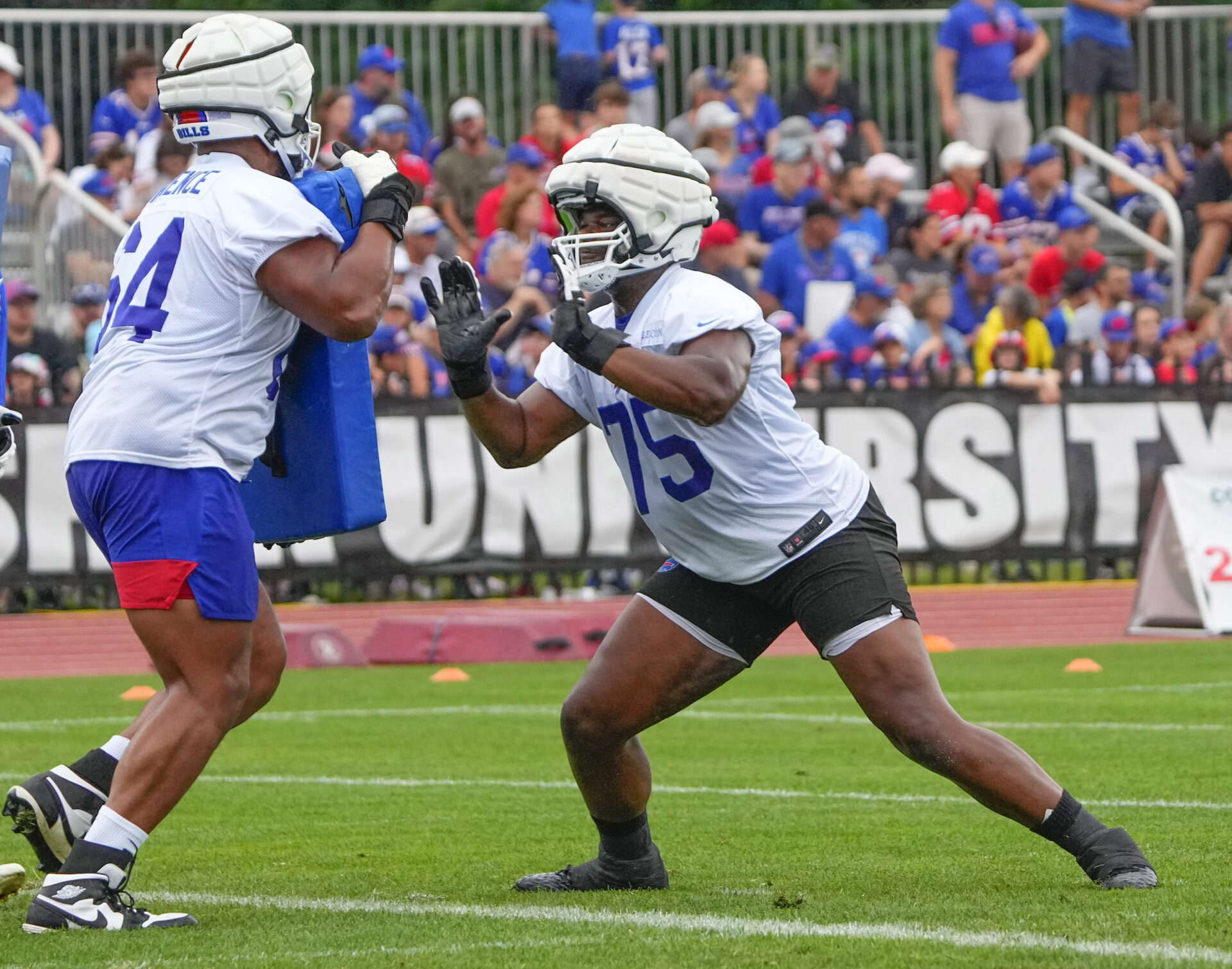Analysis
8/3/23
7 min read
Pros, Cons of Traveling For NFL Training Camp

Each year, on the night before the start of training camp, Sean McDermott begins his team meeting by explaining to the players why the Buffalo Bills spend late July and part of August practicing at a remote location.
It has been this way since 2017 when McDermott became the Bills’ head coach. He feels obligated to put the topic at the top of his address because he understands the Bills are an outlier by not holding camp at team headquarters in Orchard Park, N.Y. Fewer than a third of the NFL’s 32 clubs leave home as they begin earnest preparation for the regular season.
“I think it’s because of the advances in facilities and the resources teams have now at these new facilities that people are getting,” McDermott said.
>>WATCH: Sean McDermott In His Own Words
The Bills have such a facility of their own. In 2018, franchise co-owners Terry and Kim Pegula invested $18 million to add 25,000 square feet of space to expand the Bills’ strength and conditioning, sports science and sports medicine departments.
Which, of course, begs the question: Why leave all of that behind to travel about 90 miles northeast to St. John Fisher University in Pittsford, N.Y.?
Why Teams Travel for Camp
There’s just no replicating a state-of-the-art training center on a small college campus.
“We feel there’s value to getting away for camp for the time we’re going to be here,” McDermott said. “I think a big piece of that is really the building of relationships where guys can hang out after practice and get to know one another a little bit better, whether it’s time talking football or playing cards, whatever it is.”
“Sean and I are big believers in getting away (because of) the bond that forms here,” Bills general manager Brandon Beane said. “Camp gets old after a while, but it’s fun to be here.”
In theory, there are fewer distractions at remote camps, with family and friends not present, though the Bills do allow for players, coaches and staff to have frequent visits from their loved ones. The short drive for most of them makes it doable.
Why Teams Stay Home
Nevertheless, most teams choose to stay home for camp. The main reasons are cost, convenience and comfort. Same locker room; same weight room; same meeting room; same offices; same cafeteria. Veteran players, coaches and staff members can sleep in their own beds.
In some cases, there’s a greater ability to accommodate fans and local corporate sponsors who attend practices. No long drives or, in some cases, flights are necessary.
Some fundamentals also factor into the location of training camps. A big one is the weather. Clubs based in the south might choose to spend part or all of camp where it’s a little cooler. The record heat this summer prompted the New Orleans Saints, who train in Louisiana, to shorten practices by an hour.
Before the advent of high-end training facilities where teams are based, training camps essentially had to be held elsewhere to provide a larger footprint for additional players on the roster before cuts.
“Back in the day, training camps were mostly away,” said former NFL coach Marc Trestman, an analyst for The 33rd Team. “There were no offseason workouts, so this was the first time players and coaches were together since the season. And facilities could not handle the numbers. The team could bond and focus on football.
“With the advent of the offseason programs, I believe there was not the necessity of going away for training camp. The players and coaches are familiar with each other and have essentially only spent a month away over the summer. I did not feel it hurt players to go home each night to their family.”
Doing Something Right
Conversely, McDermott sees considerable examples of what makes being away for camp so vital to the team’s fortunes. He can speak from a place of strength on this, with the Bills having won three consecutive AFC East championships and reaching the 2020 conference title game. That success recently earned him and Beane two-year contract extensions that run through 2027. Clearly, the Pegulas believe they’re doing something right.
McDermott pointed in the direction of the building at St. John Fisher that houses the cafeteria. Chairs were lined up on the walkway in front of the entrance.
“You find guys just sitting there, hanging out, getting off their feet but also just talking life,” McDermott said. “That goes a long way towards building a football team, or any team for that matter. That chemistry is important, that bond is important. If you don’t have that, it’s hard to get it once the season happens because it’s go, go, go during the season.”
Minor speed bumps also can become positives.
“I'd say the advantage of going away is that you do detach from the world that you’re used to, and everybody’s sort of muddling through together trying to figure out,” said former NFL coach Eric Mangini, an analyst for The 33rd Team. “You’re saying, ‘OK, where are the meeting rooms? Where do you go for the cafeteria?’ And there are certain inconveniences that can actually be bonding experiences.”

A Bridge Too Far
However, Mangini, who has been involved with home and away camps, sees the negatives of going to a remote location.
“I think there is a pretty big disadvantage to the amount of time and effort that goes in prior to moving a training camp, between the staff having to see the fields, see where the meeting rooms are, see the layout, talk through it, make changes, understand where you’re going to fit on the field, where your equipment is going to be, where the weight room is,” Mangini said. “There are so many things that eat up time that can be a lot more productively used watching tape, pushing the install forward. There are inefficiencies that made it to the point where I didn’t love going away.
“You’re moving your computer. Do you have the internet set up correctly? And we were doing it before the internet was really an issue, so the questions were: Do you have the printers? Do you have the playbooks? Do you have the backups? There are volumes and volumes of things that you have to push forward.”
The Goal Stays the Same
Former NFL coach Marvin Lewis, also an analyst for The 33rd Team, said whether camps are home or away, it is vital to keep the focus on the primary purpose: Create a good environment for teaching, on-field work, rest, meals and rehabilitation.
“There is a sense of camaraderie gained by going away, but teaching, etc., outweigh that,” Lewis said. “The modern facilities are bigger and set up for larger numbers and even fan access, so why spend a lot of money for a training camp location if you can better reinvest if your own facility? So, I actually favored moving back (from Georgetown, Ky.) when I was with the Bengals. No more worries about storms and losing servers and video access, or players complaining more often about meals and so forth, or access to our doctor and MRI, etc.
“I will say this, though — I loved the humidity in Georgetown and Cincinnati. I thought it helped prepare us for September and was an advantage.”
Vic Carucci has been a national editor for NFL.com and a contributor to NFL Network, a senior editor for the Cleveland Browns and an NFL writer and columnist for the Buffalo News. Follow him on Twitter at @viccarucci.






